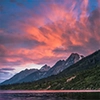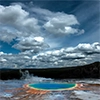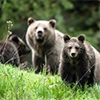Grand Teton National Park has quite the history when it comes to its founding! You ready for this rollercoaster ride? Chapter 1: As a brief aside, we’re talking about the Rocky Mountains’ youngest range (and one of the youngest in the world!), which happens to have some of the oldest rocks you’ll find on the continent. Chapter 2: John D. Rockefeller, Jr., purchased a whole lot of land in northwest Wyoming in the mid 1920s with the initial intention of eventually donating it to the government. For identity protection, he bought 33,000 acres under the Snake River Land Company name, and he kept it for 15 years. He eventually threatened to sell it, which prompted action by FDR—see Chapter 4. Chapter 3: President Calvin Coolidge, despite vociferous Congressional dissent, signed the park into existence in February, 1929, less than a week before his presidency concluded. The act protected 96,000 acres of land, including the 40-mile-long Teton Range and six glacial lakes. Chapter 4: Area residents were strongly opposed to any further expansion, so when President Roosevelt unilaterally established a wildlife reserve called Jackson Hole National Monument in 1943 that encompassed most of the adjacent valley, angered ranchers created a massive cattle-drive by rustling hundreds and hundreds of cattle across the designated area. Their legendary protest was led by Academy Award-winning, and highest paid at the time, actor Wallace Beery. Chapter 5: During and after WW2, Wyoming tried to have the JHNM rescinded. When no one was willing to budge after many repeated attempts, a compromise was reached: 1. The Jackson Hole National Monument would be added to the original Coolidge-established park. 2. In exchange, ranchers were allowed to keep their existing grazing rights. 3. The National Elk Refuge—the southern end of the JHNM—would not be included in the merger, but the elk herd would still be partly managed by the state and allow for some hunting. 4. Wyoming was exempted from the Antiquities Act, meaning Congress has to approve the establishment of further national monuments in the state rather than the president being able to do so alone via executive order. Chapter 6: Thus, Grand Teton National Park came to be (re-)established in its current size and area on September 14, 1950, by President Truman.

The Rollercoaster History of Grand Teton National Park

©2023 See Jackson Hole



